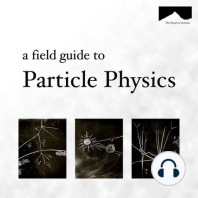5 min listen
The Cascades
ratings:
Length:
6 minutes
Released:
Feb 25, 2022
Format:
Podcast episode
Description
The Field Guide to Particle Physics : Season 2https://pasayten.org/the-field-guide-to-particle-physics©2022 The Pasayten Institute cc by-sa-4.0The definitive resource for all data in particle physics is the Particle Data Group: https://pdg.lbl.gov.The Pasayten Institute is on a mission to build and share physics knowledge, without barriers! Get in touch.The Cascade ParticlesPrepare for trouble! And make it double! Today we confront the two Cascade or Xi /ksee/ baryons which each have a PAIR of strange quarks.Xi minus checks in with a mass of about 1322 MeV, making it the heaviest baryon we’ve encountered so far. This is just as well, as it comprised of two of those heavier, strange quarks. Together with a third, down quark, it also has a total electric charge of minus 3 thirds or… minus one.Xi 0 is just a little bit lighter with a mass of 13 hundred and 14 MeV. Its two strange quarks are paired with an up quark, which gives it an electric charge of twice minus one third PLUS one third, or… zero.Decays of the Xi minusLike many strange particles, the cascades take quite a while to decay. The Xi minus takes a solid fraction of a nano-second, the usual time it takes to convince one of those strange quarks to decay into an up quark. The result? The strange-strange-down bag of quarks converts to up-strange-down bag, otherwise known as the Lambda 0 baryon. As usual, that decay is accompanied by some other junk, and in this case the net result is a pi minus.As we’ve already seen, the Lambda 0 and the pi minus are both unstable themselves. The former converts to either a proton or a neutron and the latter typically decays to a muon and then an electron.If you tried to sketch that all out, you’d find a LONG decay chain of a LOT of different particles. This gives the cascades their name. Producing ONE Xi baryon results in a cascading SHOWER of particles all the way down to that familiar, stable stuff like protons, neutrons and electrons.Now the Xi minus ALMOST ALWAYS decays to the Lambda 0 with a pi minus. Like 99.8 percent of the time! The rest of the time we find some cuter decays, each incredibly rare, happening less than a thousandth of a percent of the time. These rarer decays shed some rather alarming light on the very identity of the strange quark. But BEFORE we get to that, we should talk about the Xi 0.Decays of the Xi 0The Xi 0 takes about TWICE as long as the Xi minus to decay, which is still, only a third of a nano-second. What’s short for humans is a seriously overripe old age for an elementary particle.Like it’s partner, the Xi 0 decays into a Lambda0 with a pion. This time a neutral pion. This happens 99.5% of the time. These decays are a little twisted.Its is the same thing we saw with those charged sigma baryons. We need to convince an a bag of of three quarks: up-strange-and-strange, to decay in something that looks like the up-down-strange bag of the Lambda zero. This is troublesome precisely because the strange quark ONLY EVER decays to an up quark.As with decays of the Sigma baryons, things just need to rearrange a little bit. The Sigma Plus you might recall decays into a proton and a pi zero thanks to a W boson. Similarly, one strange quark of the Xi0 decays to an up quark by emitting a W- boson. The W- decays to a down-anti-upquark pair so fast the rest of the quarks barely notice. The down quark runs away with the other “up and strange” quarks from the original Xi 0, and the anti-up quark leaves with the freshly minted up quark as a neutral pion.If that sounds convoluted, it is. It helps to have a diagram to look at, which you can do on our website, pasayten.org.Incidentally, the other, rarer decays of the Xi zero match up quite nicely what you’d expect from those rare decays of the Xi minus. More on those in a later episode.Spin Angular MomentumThe spin angular momentum of both Xi 0 and Xi minus is simply hbar over 2, just like the proton and the neutron. Well those and the three Sigma baryons AND the Lambda
Released:
Feb 25, 2022
Format:
Podcast episode
Titles in the series (49)
The Electron Cloud: Atoms are modeled by a nucleus surrounded by an electron cloud. We’ve discussed the nucleus earlier; it’s the hard center of the atom. It’s really, really small, as small as a speck of dust in the middle of a baseball stadium. Despite that fact, the nucle by The Field Guide to Particle Physics
